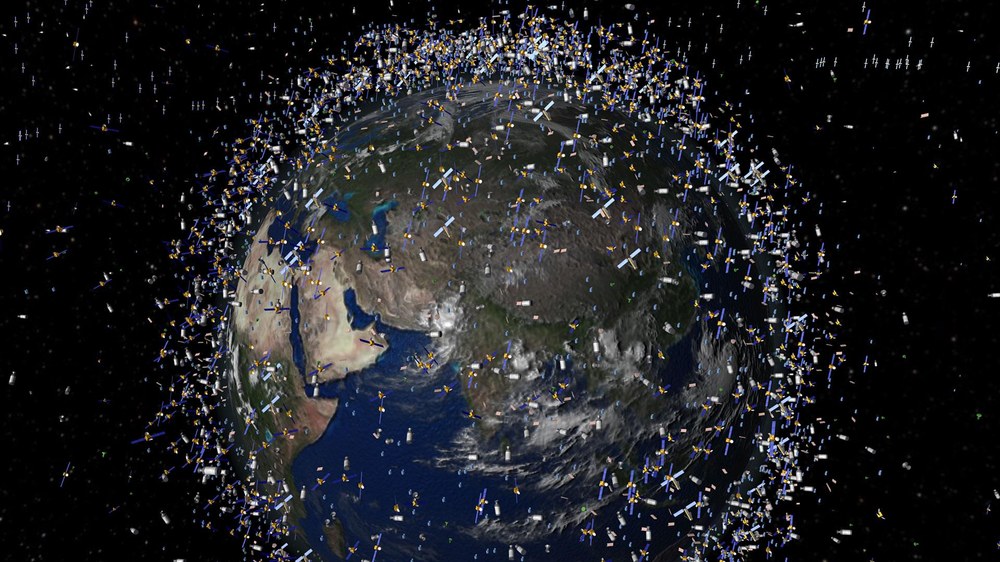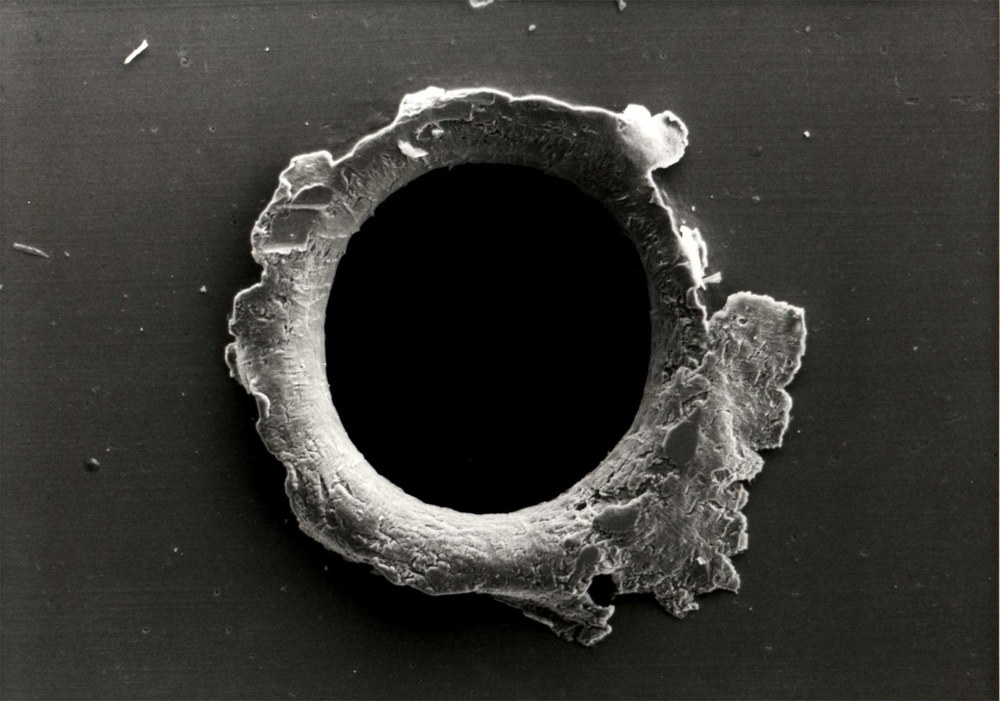Space Debris
It is therefore important to gain a better understanding of the situation and its potential impact on satellites and Earth. For this reason, the German Space Agency at DLR is funding research activities in the field of space debris as part of the 'Space Systems and Robotics' programme. The German Space Agency is also actively involved in international committees that address issues relating to space debris. One of the objectives of this involvement is to take measures against the accumulation of space debris through international agreements.
What is space debris?
Space debris, also known as orbital debris, includes all human-made objects that are in Earth orbit but which have no function. Typical examples of space debris are disused rocket upper stages and decommissioned satellites, but they also include astronauts' lost tools. However, the largest contribution is debris caused by explosions, the break-up of spacecraft or collisions in orbit.
There are currently around 29,000 recorded and catalogued pieces orbiting the Earth. Typically, these objects have a diameter of at least ten centimetres. Based on models - such as the ESA MASTER model developed in Germany - scientists estimate that there are a total of around one million particles larger than one centimetre and 330 million particles larger than one millimetre in Earth orbit.
How is space debris monitored?
Objects larger than ten centimetres in diameter are routinely measured and catalogued by a network of radar systems and telescopes. These monitoring stations are operated by the USA. The German large-scale radar system TIRA in Wachtberg near Bonn can even detect smaller debris particles up to a diameter of around two centimetres. Such measurements are used to check statistical models on the number of small particles. Analyses of satellite parts that have been brought back to Earth, such as those from the Hubble Space Telescope, serve the same purpose. These exhibited numerous impacts of micrometre to millimetre-sized particles.
Is space debris evenly distributed around the Earth?
No. The density of space debris in Earth orbit - in other words, the number of particles per cubic kilometre, varies greatly. Most space debris is produced in the areas of greatest space activity. The greatest density is therefore found at an altitude of 800 to 900 kilometres. These orbits are frequently used by Earth observation satellites, such as the European environmental satellite Sentinel-5P. The International Space Station ISS is located in a lower orbit at an altitude of around 350 kilometres. The density of space debris there is less than a tenth of the density at 900 kilometres. Space debris in such low orbits also re-enters Earth's atmosphere relatively quickly and burns up, resulting in a 'natural cleaning effect'.
Is the ISS protected against space debris?
The ISS is designed to withstand impacts from pieces of space debris up to approximately one centimetre in diameter. In fact, there has already been some minor damage to the Space Station from the impact of millimetre-sized pieces. Larger pieces of space debris with known trajectories are regularly checked to see whether they pose a risk to the ISS. If the risk of a collision is too great, the ISS must perform an evasive manoeuvre. Such avoidance manoeuvres are also carried out with satellites such as Sentinel-5P or the German radar satellites TerraSAR-X and TanDEM-X.
What risk does space debris pose for spaceflight in general?
In general, the risk to spaceflight is not yet very high. Small particles (up to one millimetre in diameter) often strike satellites, but their effect on the spacecraft is minimal or non-existent. However, some collisions are already known to have caused major damage in space. The first and so far only event in which two still intact spacecraft collided took place on 10 February 2009. The active US satellite Iridium 33 collided with the decommissioned Russian satellite Cosmos 2251. Almost 1700 pieces of debris generated by this collision have been identified to date. In addition, numerous small pieces have not been identified.
How long does space debris remain in Earth orbit?
The time that an object remains in orbit depends heavily on its orbital altitude. The parts lose altitude due to friction with the Earth's thin residual atmosphere. The density of the Earth's atmosphere, however, decreases sharply with increasing orbital altitude, so that the braking effect is reduced there. At an orbital altitude of 400 kilometres, space debris remains in space for about a year. One example is the tool bag that an US astronaut lost during an external mission to the ISS on 18 November 2008 at an orbital altitude of around 350 kilometres. Less than a year later, on 3 August 2009, the object entered Earth's atmosphere and burned up completely. The lifespan of objects at an orbital altitude of 800 kilometres can be as great as 150 years or more.
In addition to the orbital altitude, there are other factors that affect the lifespan. For example, the shape and weight of a piece of debris influence the trajectory. Flat, thin pieces enter Earth's atmosphere faster than compact objects. This is comparable to throwing a sheet of paper. If you try to throw a piece of paper, it is very quickly slowed down by air resistance and falls to the ground. If you crumple up the piece of paper, you can easily throw it several metres. This is because the crumpled up piece of paper has much less air resistance for the same weight.
Finally, the Sun also affects the duration of the orbit. The sun's activity is not constant, but decreases and increases again in an approximately 11-year cycle. Greater solar activity causes the Earth's atmosphere to expand further. As a result, the air resistance of the atmosphere increases and the orbital altitude of space debris and satellites decreases quicker. This also means that more space debris re-enters during periods of strong solar activity than during periods of weaker solar activity.
Do objects entering the Earth's atmosphere pose a danger?
When a satellite, rocket upper stage or space debris enters the Earth's atmosphere, typically 60 to 90 percent of its mass burns up at high altitudes, depending on the material and structure. However, larger parts that survive re-entry can cause damage when they hit the Earth's surface. Despite a large number of re-entries - around 18,000 up to 2002 with a total mass of around 27,000 tonnes - fewer than 250 pieces of debris have been found during this time.
As the majority of Earth's surface is covered by oceans, it is likely that most pieces fell there. In the case of controlled re-entries, such as from the Russian Mir station or the European ATV spacecraft, a re-entry corridor is specifically selected so that it lies above water in order to minimise the risk of damage.
Have people already been harmed by orbital debris?
As far as we know, no one has yet been harmed by falling space debris.
What can be done about it?
One important measure against space debris is to prevent it from being created in the first place. Nowadays, there is an international consensus on the most important measures to prevent debris. These include eliminating sources of danger for unintentional explosions (for instance emptying fuel residues from tanks), not deliberately destroying spacecraft and limiting the time spent in orbital regions that are important for spaceflight. In addition, parts should no longer be unnecessarily released into orbit in future. One example is protective covers for sensitive satellite components. Instead of simply detaching them, they could be designed with a folding mechanism.
DLR is actively involved in international committees to work on measures to prevent space debris. These include the International Organisation for Standardisation (ISO) and the United Nations Committee on the Peaceful Uses of Outer Space (UNCOPUOS), as well as the Inter-Agency Space Debris Coordination Committee (IADC). The latter is an international association of space agencies to exchange current research results and develop prevention measures. DLR ensures that the requirements agreed there are fulfilled in current German projects.
What measures are being taken today to prevent satellite crashes?
Satellite crashes cannot be avoided today. Currently, 100 to 150 tonnes of space debris (satellites, rocket upper stages, etc.) enter the Earth's atmosphere every year. When the Sun is more active, the annual entry rate increases slightly, and technologies for capturing individual satellites and bringing them down in a controlled manner are still under development.
The first demonstration missions to show that such a procedure is technically feasible are not expected for at least a few years. But even when these technologies are available, it will only be possible to re-enter a few objects in a targeted manner, and not the majority of satellites and rocket upper stages.
Are there any future plans to prevent satellites from crashing uncontrollably?
In current satellite projects, a risk analysis is carried out for the re-entry of the satellite into the Earth's atmosphere. This allows engineers to take technical measures to reduce the risks of re-entry as early as the satellite design stage. The aim is to ensure that the probability of any person being seriously injured by possible falling debris is below a limit of 1:10,000.



